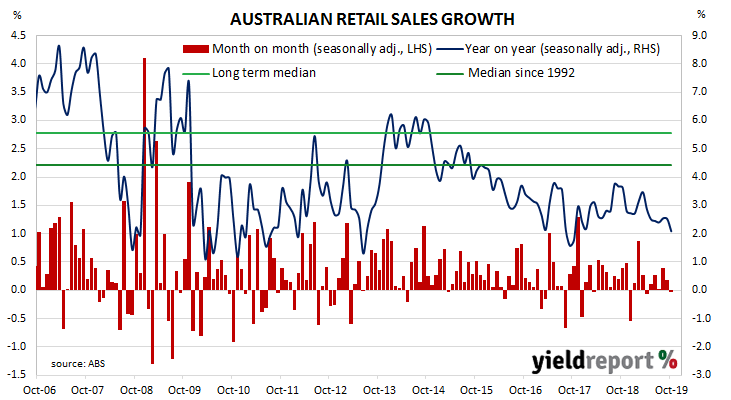Growth figures of domestic retail sales have been declining since 2014 and they reached a low-point in September 2017 when they registered a growth rate of just 1.5%. They then began increasing for about a year, only to stabilise at around 3.0% to 3.5% through late 2018 before beginning another period during 2019 in which annual growth rates fell.
According to the latest ABS figures, total retail sales were flat in October on a seasonally-adjusted basis, under the expected increase of +0.3% and less than September’s 0.2% increase. On an annual basis, retail sales increased by 2.1%, a slower rate than September’s comparable figure of 2.5%.
Westpac senior economist Matthew Hassan said, “The spending ‘strike’ of Q3 looks to have extended into early Q4 with still no evidence of a boost from tax refunds or interest-rate cuts…” ANZ economist Adelaide Timbrell put the lack of consumer enthusiasm to spend down to a combination of “household debt levels, rising cost of living, consumer pessimism and increasing labour market risks”, noting annual sales growth had fallen to a two-year low. US Treasury yields had increased during the previous night, lending support for higher yields in the domestic market despite the lacklustre sales figures. By the end of the day, 3-year ACGB yields had crept 1bp higher to 0.69%, the 10-year yield had gained 3bps to 1.09% while the 20-year yield finished 5bps higher at 1.52%.
US Treasury yields had increased during the previous night, lending support for higher yields in the domestic market despite the lacklustre sales figures. By the end of the day, 3-year ACGB yields had crept 1bp higher to 0.69%, the 10-year yield had gained 3bps to 1.09% while the 20-year yield finished 5bps higher at 1.52%.

